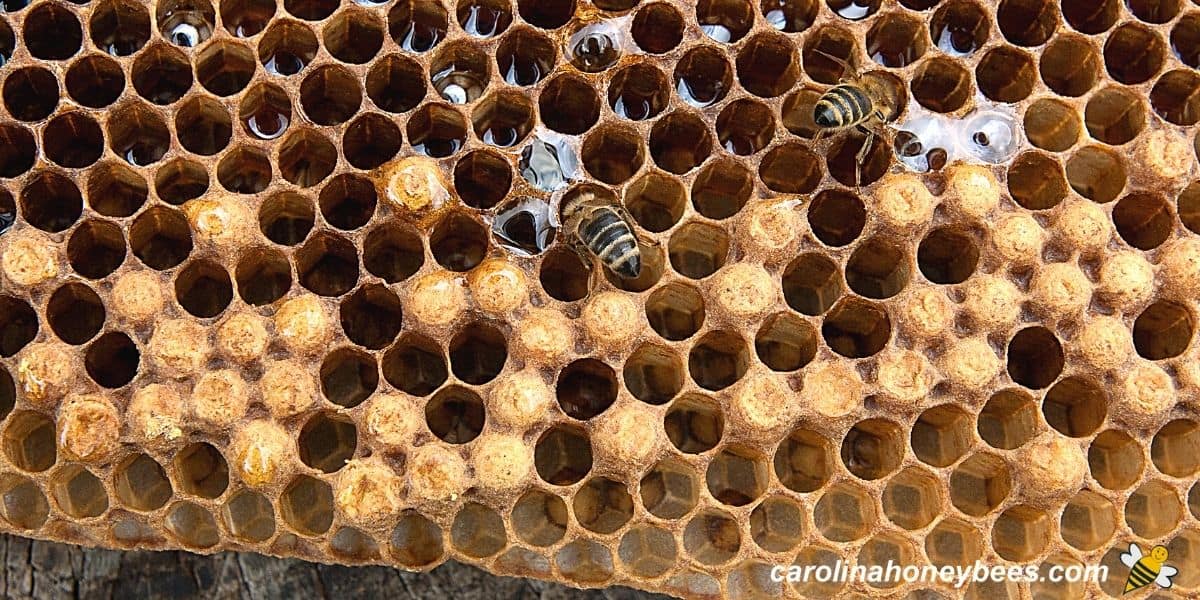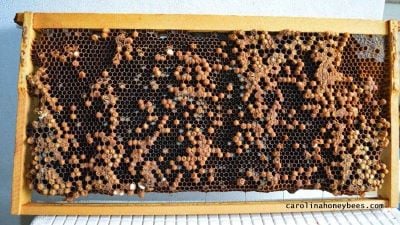Do You Have a Drone Laying Queen?
One situation that can cause concern for a beekeeper is an overabundance of drone brood with little or no worker brood. This is not ideal. And, the beekeeper must consider that they may have a drone laying queen. A colony in this condition is doomed without assistance.

The major role of the queen bee is to lay eggs – both fertile (become workers-queens) and unfertile (male bees or drones) eggs. It is normal to have drone brood during the warm season. But, you should find mostly worker brood in the brood nest.
A Drone Laying Queen Hive
Unfortunately, this problem occurs more often than you may think. If the colony recognizes a problem early enough, the bees may kill their queen and replace her. But, sometimes that does not happen.
Amazingly, a queen can choose whether or not to fertilize eggs that she lays. If the queen lays an egg and does not fertilize it with semen stored in her body, it will develop into a drone (or male bee). Fertilized eggs develop into worker bees.
The queen bee produces a limited number of eggs during her life. But, her production of fertilized eggs is limited by the amount of sperm (semen) stored in her body. When that semen runs out, she can only lay unfertilized eggs.
While drones are important to the colony, it is the thousands of workers that go out and collect the resources needed for the hive.
The beekeeper that notices properly laid eggs in the comb but sees only capped drone brood can assume that they may have a queen problem.
What is Drone Brood?
Bee brood is the term used to describe developing bees. Drones are male bees of the colony and they do no work to support the hive.
Their role in the colony is to leave the hive and mate with virgin queens. In this way, the genetics of the hive are spread. Some drone brood during the warm months is a good sign of a healthy colony and perfectly natural.
What Does Drone Brood Look Like ?
Looking inside the honeycomb cells of the brood nest, to the untrained eye – drone larvae doesn’t look much different than worker larvae. They are both small white grubs.
When bee larvae are ready to pupate, workers cap the cells with a wax covering. At this stage of the honey bee life cycle, it is much easier to distinguish drone brood from worker brood.
The caps of workers form a smooth pattern that is slightly raised from the surface of the comb. But, drone brood caps look different.

The capped cells of drone brood will protrude slightly from the honeycomb surface. This creates a bullet appearance. In most cases, the bees have drone brood grouped together along the edges of the brood nest.
If drone brood is the only thing you have – that’s not good. Either you have a drone laying queen or laying workers. Both situations require help from the beekeeper if the colony is to survive.
Hive Inspections Spot Queen Problems
Timely hive inspections are an important part of managing honey bees. Perhaps, the most important aspect is to verify the hive’s queen status.
It is not enough to just see her in there. We need to know that she is capable of producing workers. The best way to evaluate your queen is to look at the brood pattern.

Evaluating the Brood Pattern
Learn how to recognize a good brood pattern? This takes a bit of experience but you want to see compact sections of mostly worker brood.
Worker brood is a smooth expanse of capped cells (or larva). You may notice what looks like a pattern on the covers of capped brood. This is normal and no cause for concern.
Brood should be placed together in a general area. The brood nest often occupies several frames in the hive.
Tan is the common color for capped cells because the bees re-use valuable beeswax for this purpose. A few empty cells is no problem.
How much brood should we see? Well, that depends. During late Fall, very early Spring or times of nectar dearth, you may not see a lot either type of brood.
Lack of Worker Brood Signals Problems
If it is a time of colony build up with ample food available, lack of a good solid worker brood pattern may mean trouble. There are usually two possibilities for this issue:
- drone laying queen
- laying workers

Young Queens Can Become Drone Layers
Though it is often considered a problem for older queen bees, that is not always the case. Why would your nice fertile queen go bad? Well, even a young queen bee can run out of stored semen.
In bee reproduction, the young queen bee mates with several drones. Semen (sperm) are stored in a special organ inside her abdomen.
When the semen supply is exhausted, she will be unable to fertilize the eggs that she lays. Now she is…. you guessed it – a drone laying queen.
It is not uncommon to receive queens that are not well mated. This is especially true in early Spring when bad weather makes mating more difficult. No one can really look at a freshly mated queen and know what her potential is.
Poor Brood Pattern of Failing Queen
When the queen bee begins to fail, you may find large sections of drone brood. Instead of it being mainly along the edges of the frames, the brood might be scattered across or in a tight pattern.
Also, these bullet shaped cells protruding from the honeycomb may be found in worker sized cells. Perhaps, the queen is laying and trying to fertilize the eggs.
If the colony is completely queenless, the colony tries to make a new one. But, they are not always successful.

Laying Workers
If a colony remains without a queen for some time, some of the workers will begin to lay egg. This usually happens after 2-3 weeks without any worker brood in the hive.
Worker bees can not mate so they only produce drones. We call these individuals “laying workers “.
They will continue to produce drones until the colony collapses. They can not make a new queen with no fertilized eggs.
Note: Some beekeepers will refer to the laying worker as a drone layer (and that’s true). But, the term drone layer is also used to refer to a failed queen.
Sign of Drone Layer Queen?
How do you know if you have a drone layer queen or laying workers? We all know it is not always possible to find that elusive queen bee.
Drone brood produced by a queen tend to be grouped together – in patches at least. You will see one egg per cell as is normally laid by the queen.
Workers that are laying tend to scatter a few eggs here and there. And, they often lay more than 1 egg in each cell.
In severe situations, you may notice that most of the adult bees on the comb are drones instead of regular workers. There comes a point where fixing a failing beehive is not possible.

How to Save a Colony with a Drone Laying Queen
There are several different ways to deal with a drone laying hive. The one you choose depends on your preference, the current condition of the colony and resources available.
- give the drone layer hive a new queen
- add resources for bees to make their own queen
- combine the colony with a queen right hive
Any colony that has only been producing drones for a while will be low on worker population. If you catch the problem while the bee population is still good, you may be able to purchase a new queen for your bees.
After requeening the hive, check back in a couple of weeks to be sure the new queen is accepted and laying.

Give the Hive Resources to Make Their Own Queen
In the warm season, there is another way to fix a drone laying queen problem. This is the advantage of having more than 1 beehive – you can share resources.
Remove the poor queen from the hive and give them a frame with fresh eggs. Or very tiny larva – worker brood. This allows the colony to make a new queen for themselves.
This only works well if the problem hive has a strong population of bees. If the colony has been in trouble for a while – giving them eggs to raise a new queen is not as likely to be successful.
Combine the Drone Layer Colony with Another
One of the easiest ways to get a drone laying queen hive back on the path to success is to combine the colony it with a good hive.
A honey bee colony full of drones is running out of time. Yet, if the hive still has a fair population of bees – perhaps they can be saved and become part of another productive colony.
In situations where no queen is available to purchase and no frame of bee eggs is available, combining may be the only option to save a failing colony.
No matter why it has happened, a drone layer is a death sentence to the colony-without beekeeper intervention. Colony size will decrease until pest, disease or robber bees cause the colony to collapse.
A Final Word
Thankfully, nature has a wonderful plan for honey bee colonies that works most of the time. Still, some colonies fail. As beekeepers, we wish to protect our bees and investment as much as we can. If you notice a drone laying queen in time, you may be able to save the rest of the colony if you act swiftly.

